Table of Contents:
- Introduction
- Why Choose Battery-Operated Camping Lanterns
- Types of Battery-Operated Camping Lanterns
- Key Features to Consider
- Top 10 Battery-Operated Camping Lanterns of 2025
- How to Choose the Right Camping Lantern
- Care and Maintenance Tips
- Battery Conservation Strategies
- Budget Considerations
- Eco-Friendly Options
- FAQs About Battery-Operated Camping Lanterns
- Conclusion
Introduction
When the sun sets on your outdoor adventure, reliable lighting becomes essential for safety, comfort, and convenience. Battery-operated camping lanterns have revolutionized how outdoor enthusiasts illuminate their campsites, offering powerful, portable, and user-friendly lighting solutions for everything from weekend family camping trips to extended backcountry expeditions.
Unlike traditional fuel-based lanterns, modern battery-powered options eliminate concerns about fuel spills, fire hazards, and noxious fumes, making them the preferred choice for environmentally conscious campers. With continuous advancements in LED technology and battery efficiency, today’s camping lanterns deliver exceptional brightness, impressive runtime, and versatile features to enhance your outdoor experience.
In this comprehensive guide, we’ll explore everything you need to know about battery-operated camping lanterns, from the various types available to essential features worth considering. We’ll also review the top models of 2025, provide expert maintenance tips, and answer common questions to help you make an informed decision for your next outdoor lighting purchase.
Why Choose Battery-Operated Camping Lanterns
Battery-operated camping lanterns offer numerous advantages over traditional lighting options, making them increasingly popular among outdoor enthusiasts. Here’s why they’ve become the go-to choice for campsite illumination:

Safety First
- No open flames – Eliminates fire hazards in dry conditions or around tents
- No fuel handling – No risk of accidental spills or exposure to flammable materials
- Cool operation – LEDs generate minimal heat, reducing burn risks
Convenience and Ease of Use
- Instant light – No matches or lighter needed
- Adjustable brightness – Many models offer multiple light settings
- Reliable operation – Works in wind and varying weather conditions
Environmental Benefits
- No emissions – Produces no smoke, fumes, or carbon monoxide
- Rechargeable options – Reduces battery waste with USB-rechargeable models
- LED efficiency – Uses less energy while providing bright illumination
Versatility
- Multiple mounting options – Can be hung, stood on surfaces, or magnetically attached
- Various lighting modes – Many offer directional light, 360° illumination, or even colored options
- Indoor/outdoor use – Safe for use inside tents or cabins
Portability
- Lightweight design – Easy to pack and carry
- Compact options available – Some models collapse for space-saving storage
- Durable construction – Built to withstand the rigors of outdoor use
The combination of these benefits makes battery-operated camping lanterns an excellent investment for anyone who enjoys outdoor activities, from casual campers to serious wilderness explorers.
When camping in adverse weather conditions, reliable lighting becomes even more critical. Pair your lantern with appropriate rain gear for complete protection – check out our Best Rain Jacket for Hiking: Ultimate Guide for Trail Protection to stay dry while enjoying your illuminated campsite.
Types of Battery-Operated Camping Lanterns
Understanding the different types of battery-operated camping lanterns will help you choose the right option for your specific needs. Here’s a breakdown of the main categories:

Traditional Lantern Style
These classic-looking lanterns typically feature 360-degree illumination with a carrying handle on top. They’re designed to sit on a table or hang from a hook, providing ambient lighting for an entire area.
Pros:
- Familiar design with stable base
- Generally provides good all-around illumination
- Often includes hanging hooks or handles
Cons:
- May be bulkier than other options
- Sometimes heavier due to larger battery capacity
Collapsible/Pop-Up Lanterns
These space-saving lanterns can be compressed when not in use, making them ideal for backpackers and those with limited packing space.
Pros:
- Extremely compact for easy transport
- Lightweight design
- Often include built-in hanging options
Cons:
- May not be as bright as larger models
- Generally less durable than rigid designs
Hybrid/Multi-Function Lanterns
These versatile units can function as lanterns, flashlights, and sometimes even power banks for charging electronic devices.
Pros:
- Multiple functionalities in one device
- Often feature directional and ambient lighting options
- Added utility for emergency situations
Cons:
- Multiple functions may compromise performance in any single function
- Can be more complicated to operate
Specialty Lanterns
This category includes tactical lanterns with extreme brightness, mini lanterns for personal use, and decorative lanterns that prioritize aesthetics alongside functionality.
Pros:
- Designed for specific use cases
- Often excel in their specialized purpose
- May include unique features not found in general-purpose lanterns
Cons:
- May lack versatility
- Often more expensive for specialized features
| Lantern Type | Best For | Average Weight | Typical Battery Life |
|---|---|---|---|
| Traditional | Car camping, base camps | 1-3 lbs | 30-300 hours |
| Collapsible | Backpacking, minimalist camping | 4-12 oz | 12-100 hours |
| Hybrid | Emergency preparedness, versatile needs | 8-20 oz | Varies by function |
| Specialty | Specific activities or aesthetic preferences | Varies | Varies |
Key Features to Consider
When selecting a battery-operated camping lantern, several key features will determine how well it meets your outdoor lighting needs. Here’s what to look for:
Brightness and Light Modes
Brightness, measured in lumens, is perhaps the most critical factor to consider. Higher lumens mean more light output, but also typically result in shorter battery life.
- Low brightness (50-150 lumens): Adequate for reading in a tent or personal use
- Medium brightness (150-300 lumens): Good for small group activities or lighting a small campsite
- High brightness (300-1000 lumens): Ideal for illuminating larger areas or providing security lighting
- Ultra-bright (1000+ lumens): Professional-grade lighting for search and rescue or large group camping
Most quality lanterns offer multiple light modes, which may include:
- High/Medium/Low settings: For adjusting brightness to extend battery life
- Directional options: Focus light in specific areas
- Red light mode: Preserves night vision and doesn’t attract insects
- SOS/Emergency flashing: For signaling in emergency situations
Battery Type and Life
The type of batteries used significantly impacts performance, convenience, and long-term cost.
Common Battery Types:
- Disposable batteries (AA, AAA, D-cell): Readily available but create waste and recurring costs
- Rechargeable batteries (Ni-MH, Li-ion): More eco-friendly and cost-effective over time
- Built-in rechargeable battery: Convenient but may limit runtime when away from charging sources
- Hybrid power systems: Can use either disposable batteries or rechargeable options
Battery Life Considerations:
- Runtime varies significantly based on brightness settings
- Some lanterns display battery life indicators
- Models with USB charging may also serve as power banks
- Consider how you’ll recharge or replace batteries during extended trips
Size and Weight
For backpackers and hikers, every ounce matters. Even car campers need to consider storage space limitations.
- Ultralight options: Under 8 ounces, ideal for backpacking
- Compact options: 8-16 ounces, good balance of features and portability
- Full-size lanterns: 1-3 pounds, offering maximum brightness and battery life
Consider not just the lantern’s weight but also its packed dimensions, especially for collapsible models that may reduce to a fraction of their deployed size.
Durability and Weather Resistance
Outdoor gear needs to withstand challenging conditions. Look for:
- Impact resistance: Ability to survive drops and rough handling
- Water resistance: Look for IPX ratings:
- IPX4: Splash resistant
- IPX7: Can withstand temporary immersion
- IPX8: Suitable for continuous submersion
- Temperature tolerance: Will the lantern function in extreme cold or heat?
- UV resistance: Will the housing deteriorate with sun exposure?
Additional Features
Modern camping lanterns often include extras that enhance functionality:
- Hanging hooks/loops: For suspending from tent loops or tree branches
- Magnetic bases: For attaching to metal surfaces
- Foldable stands: For directional lighting
- USB ports: For charging phones or other devices
- Remote control operation: For convenience
- Color-changing options: For ambiance or signaling
- Memory function: Remembers last used setting
- Battery level indicators: Prevents unexpected darkness
Top 10 Battery-Operated Camping Lanterns of 2025
Based on performance, features, and value, these are our top picks for battery-operated camping lanterns available today:
1. Portable LED Battery Powered Lantern with Magnetic Base and Foldable Hook
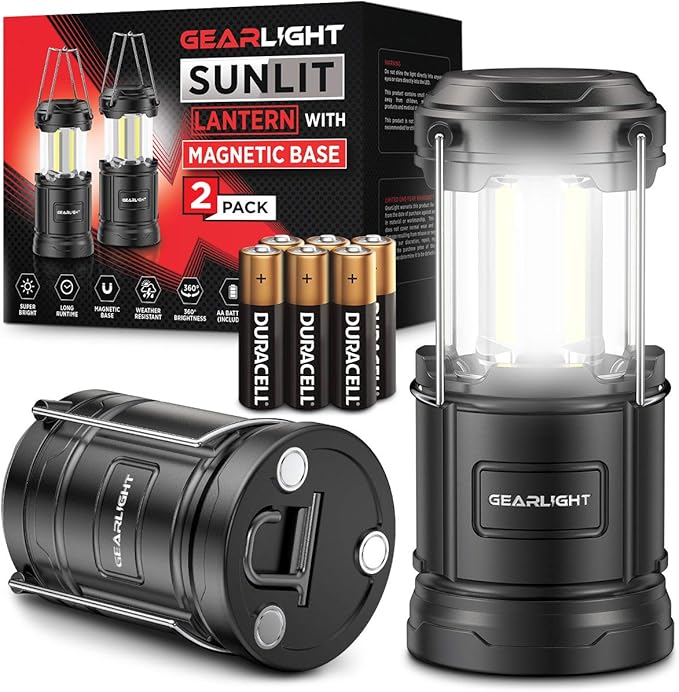
This versatile lantern combines convenience with practical features that make it perfect for various camping scenarios. The magnetic base allows for secure placement on metal surfaces, while the foldable hook provides hanging options for optimal light placement.
Key Features:
- Powerful LED illumination for whole-campsite lighting
- Magnetic base adheres to vehicle hoods, tent poles, and other metal surfaces
- Foldable hook for hanging inside tents or from tree branches
- Compact design with impressive light output
- Water-resistant construction for all-weather use
Perfect For: Car campers, weekend adventurers, and those who appreciate versatile mounting options.
2. Battery Powered LED Camping Lantern, Waterproof Tent Light with 4 Light Modes
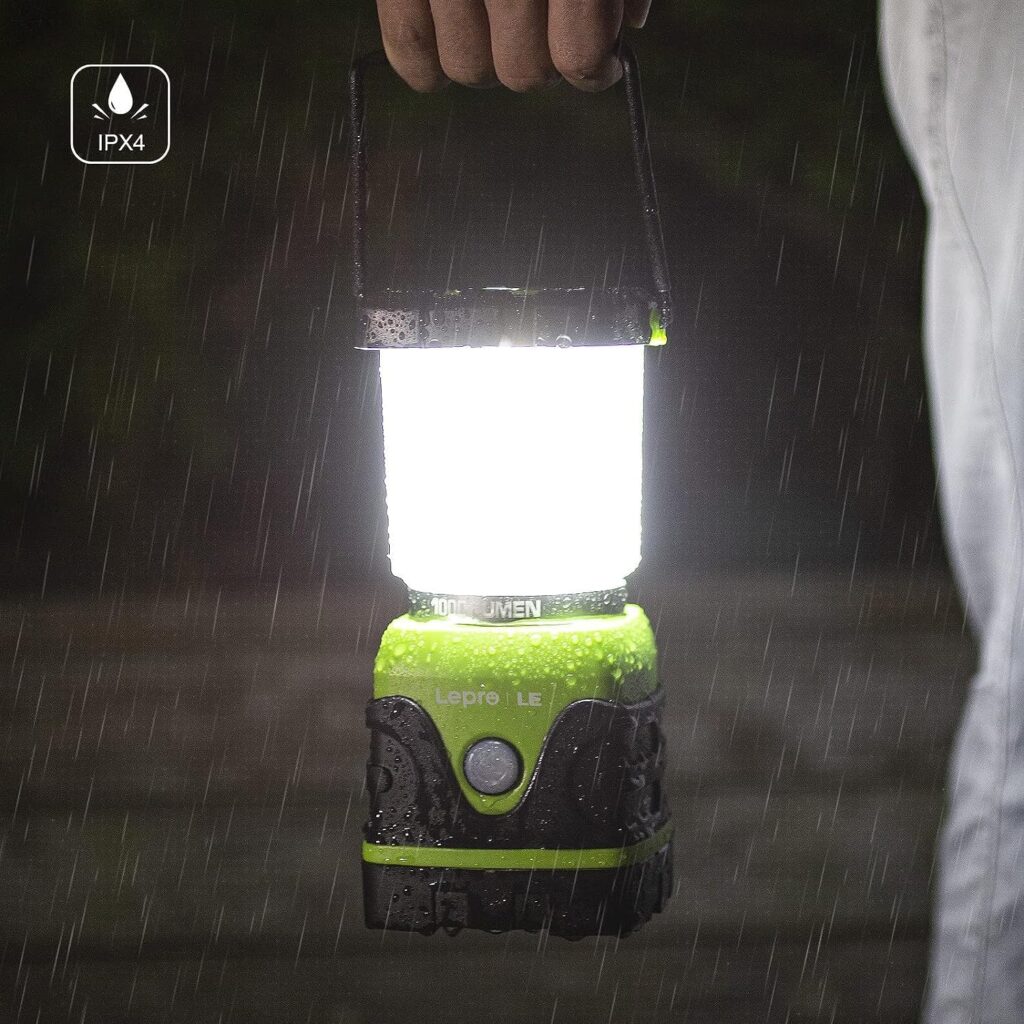
When weather becomes a factor, this waterproof lantern continues performing flawlessly. With four distinct lighting modes, it adapts to any situation from reading in your tent to illuminating your entire campsite.
Key Features:
- Four versatile lighting modes for different camping scenarios
- Robust waterproof design withstands heavy rain
- Energy-efficient LED technology maximizes battery life
- Compact and lightweight for easy packing
- Durable construction for rugged outdoor use
Perfect For: All-season campers who need reliable lighting regardless of weather conditions.
3. Vont 4 Pack LED Camping Lantern (Batteries Included)

This exceptional value pack provides comprehensive lighting solutions for family camping trips or large campsites. With four lanterns included with batteries, you can illuminate multiple areas simultaneously.
Key Features:
- Four individual lanterns for whole-campsite coverage
- Batteries included for immediate use
- Collapsible design for space-saving storage
- Lightweight yet durable construction
- Water-resistant for dependable outdoor performance
Perfect For: Family campers, group expeditions, and those who need multiple lighting points.
4. LED Camping Lantern Battery Powered 1500 Lumen COB Camping Light

When maximum brightness is necessary, this powerful 1500-lumen lantern delivers exceptional illumination. Powered by 4 D-cell batteries, it provides extended runtime with remarkable light output.
Key Features:
- Impressive 1500-lumen output illuminates large areas
- COB (Chip on Board) LED technology for efficient, uniform light
- Powered by 4 D-cell batteries for extended operation
- Durable design withstands rough handling
- Versatile hanging and standing options
Perfect For: Those requiring maximum illumination for large campsites or emergency situations.
5. Rechargeable Camping Lantern, 3000LM 5 Light Modes Camping Light

This high-powered rechargeable lantern offers an impressive 3000 lumens with five distinct lighting modes, making it one of the most versatile options available. Its rechargeable design eliminates battery waste while providing exceptional performance.
Key Features:
- Exceptional 3000-lumen maximum brightness
- Five lighting modes for different camping situations
- Rechargeable design reduces environmental impact
- Extended runtime on lower brightness settings
- Rugged construction for outdoor durability
Perfect For: Eco-conscious campers who need powerful, adjustable lighting.
6. Coleman 4D Battery-Powered Personal LED Lantern
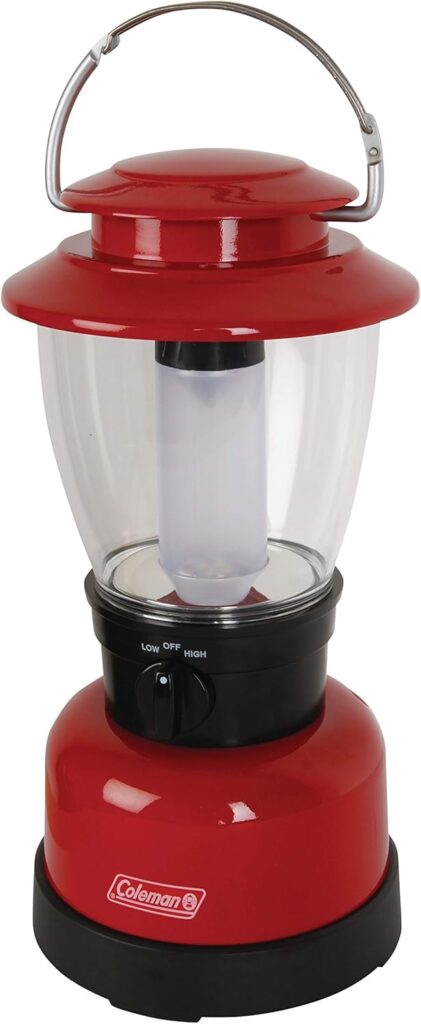
From a trusted name in camping equipment, this reliable Coleman lantern offers the perfect balance of brightness, durability, and user-friendly features. The carabiner handle makes it easy to carry or hang wherever needed.
Key Features:
- Reliable performance from a trusted outdoor brand
- Water and impact-resistant design
- Practical carabiner handle for versatile placement
- 4D battery power for extended operation
- Balanced brightness for most camping scenarios
Perfect For: Traditional campers who appreciate reliable performance and trusted brand quality.
7. Coleman BatteryGuard LED Lantern
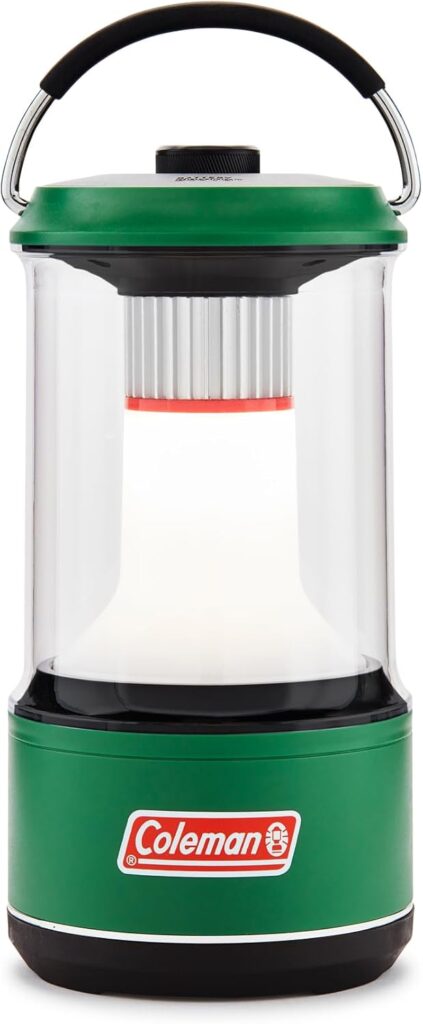
The innovative BatteryGuard technology in this Coleman lantern prevents battery drain when not in use, ensuring your lantern is ready when needed. With up to 1000 lumens of brightness and water-resistant construction, it’s ready for any adventure.
Key Features:
- BatteryGuard technology prevents battery drain during storage
- Impressive 1000-lumen maximum brightness
- Water-resistant construction for weather protection
- Multiple brightness settings for versatile use
- Trusted Coleman quality and durability
Perfect For: Occasional campers who want their lantern ready even after long storage periods.
8. USB Rechargeable Camping Lantern, 1000 Lumens LED Lantern
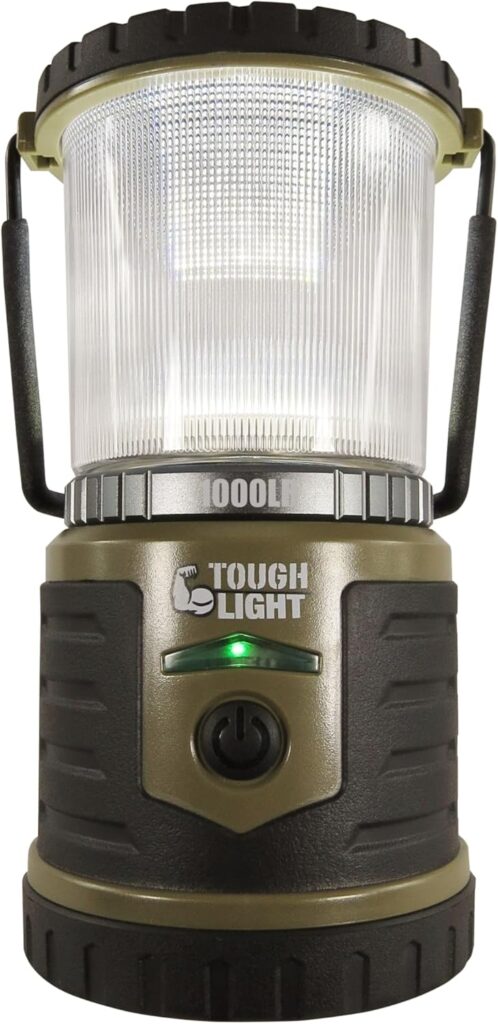
This versatile rechargeable lantern offers the convenience of USB charging combined with impressive 1000-lumen brightness. Perfect for eco-conscious campers who want to reduce battery waste without sacrificing performance.
Key Features:
- USB rechargeable design eliminates disposable battery waste
- 1000-lumen maximum brightness illuminates large areas
- Multiple brightness modes extend battery life
- Compact and lightweight design for easy transport
- Can be charged from various power sources including power banks and solar chargers
Perfect For: Tech-savvy campers and those looking to minimize environmental impact.
9. LED Camping Lantern, 2500LM Dimmable Vintage Rechargeable Lantern
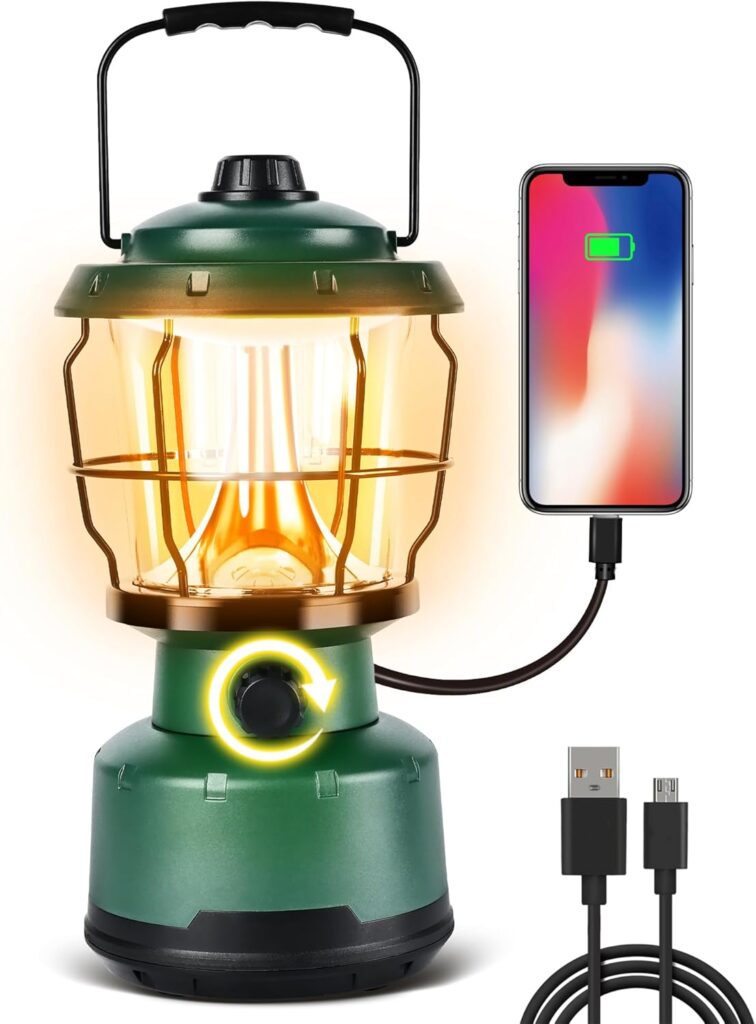
Combining classic aesthetics with modern technology, this vintage-styled rechargeable lantern delivers an impressive 2500 lumens of dimmable light. Water-resistant and rechargeable, it offers both style and substance for the discerning camper.
Key Features:
- Distinctive vintage design with modern LED technology
- Powerful 2500-lumen maximum brightness
- Fully dimmable for customized lighting levels
- Rechargeable battery eliminates disposable battery waste
- Water-resistant construction for outdoor reliability
Perfect For: Style-conscious campers who don’t want to sacrifice performance or features.
10. Eveready LED Camping Lantern X-250 (2-Pack)
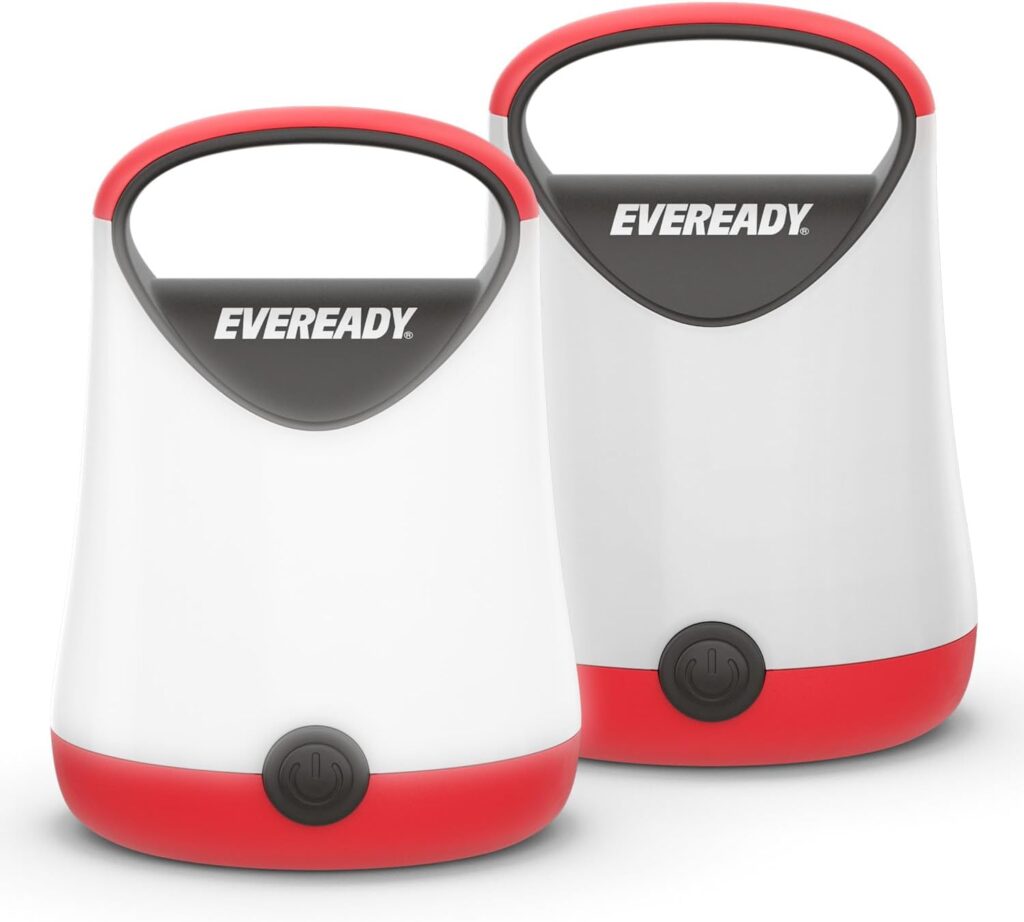
This economical two-pack from Eveready provides reliable lighting solutions with rugged water-resistant construction. These super bright tent lights offer excellent value without compromising on essential features.
Key Features:
- Value-packed two-lantern set
- Super bright LED illumination
- Rugged, water-resistant construction
- Reliable performance from a trusted battery brand
- Compact design for easy transportation
Perfect For: Budget-conscious campers who need reliable lighting without premium price tags.
How to Choose the Right Camping Lantern
Selecting the perfect battery-operated camping lantern depends on your specific outdoor activities and preferences. Consider these factors when making your decision:
Activity-Based Selection
| Activity | Recommended Lantern Type | Key Features to Prioritize |
|---|---|---|
| Car Camping | Traditional or hybrid | High brightness, long runtime |
| Backpacking | Collapsible, ultralight | Minimal weight, compact size |
| Winter Camping | Hybrid with power bank | Cold-weather performance, extra power for devices |
| Family Camping | Multi-pack or high-lumen models | Multiple light sources, durable construction |
| Emergency Preparedness | Long-runtime models | Extended battery life, multiple power options |
Intended Use
Inside Tent Lighting:
- Consider smaller, hanging models
- Look for red light mode to preserve night vision
- Lower lumens (50-200) are typically sufficient
Campsite Illumination:
- Higher lumens (300+) for broader coverage
- 360-degree light distribution
- Weather resistance for outdoor placement
Trail Navigation:
- Hybrid lantern/flashlight models
- Directional lighting options
- Compact and lightweight design
Emergency Situations:
- Long battery life on lower settings
- SOS/flashing modes
- Durable, waterproof construction
Environmental Considerations
For environmentally conscious campers, consider:
- Rechargeable models to reduce battery waste
- Solar charging capabilities for extended trips
- LED technology for energy efficiency
- Durability for longer product lifespan
Budget Planning
Quality camping lanterns are available across various price points:
- Budget-friendly ($15-30): Basic functionality, typically using standard batteries
- Mid-range ($30-60): Better durability, improved features, some rechargeable options
- Premium ($60-100+): Maximum brightness, advanced features, superior construction
Investing in a higher-quality lantern often pays off in durability and performance, especially for frequent campers.
Care and Maintenance Tips
Proper maintenance ensures your battery-operated camping lantern remains reliable for years of outdoor adventures. Follow these guidelines to maximize performance and longevity:
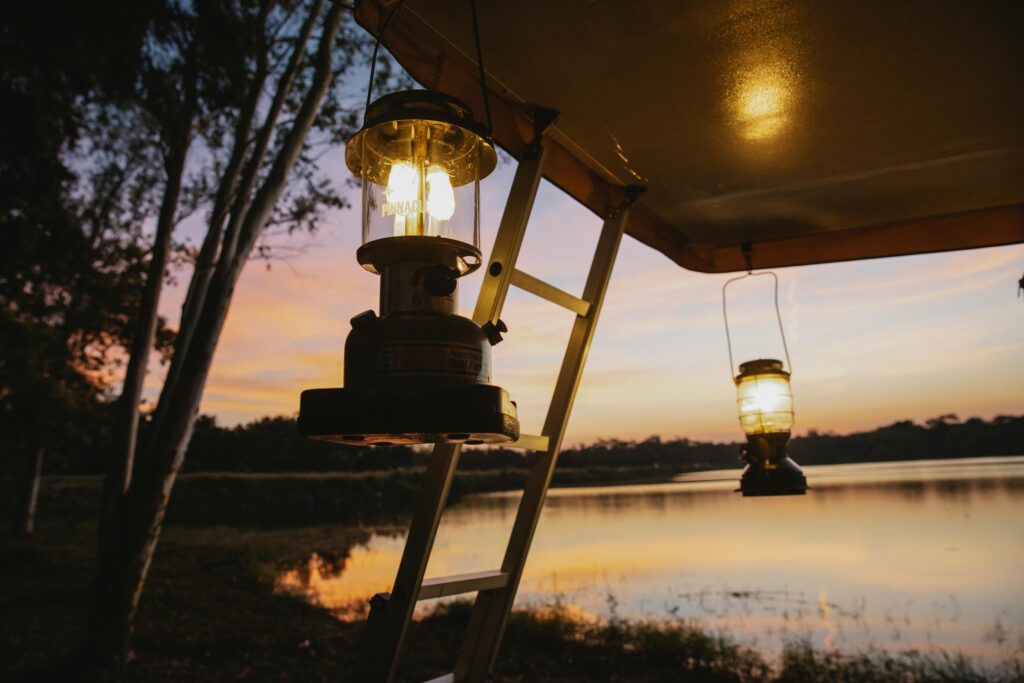
Battery Care
- Remove batteries during storage to prevent corrosion and damage from leaking
- Clean battery contacts regularly with a cotton swab and rubbing alcohol
- Store rechargeable lanterns at about 50% charge rather than fully charged or depleted
- Use fresh batteries for important trips rather than partially used ones
- Match battery types and brands when replacing multiple batteries
Cleaning and Storage
- Clean dirt and debris from lantern surfaces after each trip
- Dry thoroughly before storage to prevent moisture damage
- Store in a cool, dry place away from direct sunlight
- Use protective cases when available to prevent damage
- Periodically check seals and gaskets on waterproof models
Troubleshooting Common Issues
- Dim light: Check battery charge or clean battery contacts
- Flickering: Ensure batteries are seated properly and contacts are clean
- Won’t turn on: Check for battery polarity errors or damaged power switches
- Water inside: Dry thoroughly and replace desiccant packets if available
- Broken parts: Many manufacturers offer replacement parts for quality models
Extending Lantern Life
- Operate within specified temperature ranges to prevent damage
- Avoid unnecessary impact even with ruggedized models
- Follow manufacturer charging guidelines for rechargeable models
- Use appropriate brightness levels rather than maximum brightness when not needed
- Protect from extreme temperatures during storage and transport
With proper care, a quality battery-operated camping lantern can provide reliable service for many years of outdoor adventures.
Battery Conservation Strategies
Making your batteries last longer during camping trips not only saves money but also ensures you won’t be left in the dark. Try these proven techniques to maximize battery life:
Practical Tips for Extended Battery Life
- Use the lowest effective brightness setting – Most lanterns use significantly less power at lower settings
- Turn off lanterns when not actively needed – Even low power consumption adds up over time
- Use task-specific lighting – Headlamps for cooking, lanterns for ambient light
- Bring backup batteries or charging solutions – Solar chargers, power banks, or spare batteries
- Consider alternative light sources – Glow sticks for bathroom trips, solar path lights for walkways
Smart Usage Patterns
- Position lanterns optimally to maximize light reflection and coverage
- Use white or light-colored surfaces to reflect and amplify available light
- Implement lighting schedules – Full brightness during dinner, low light for evening activities, minimal light during sleeping hours
- Deploy multiple smaller lanterns strategically rather than one bright central light
- Take advantage of natural moonlight when available
Technical Optimization
- Use lithium batteries in cold weather – They outperform alkaline in low temperatures
- Keep rechargeable batteries warm in cold conditions to maintain capacity
- Allow LED lanterns to cool down periodically – Heat can reduce efficiency
- Remove batteries from lanterns not in use for extended periods
- Use high-quality batteries – Premium batteries often provide better value despite higher upfront cost
By implementing these strategies, you can significantly extend your lighting resources during camping trips, especially important for extended backcountry adventures where recharging options are limited.
Budget Considerations
Battery-operated camping lanterns are available across a wide price spectrum. Understanding what you get at different price points helps make informed purchasing decisions:
Value Analysis by Price Range
Budget Models ($15-30)
- Basic functionality with fewer light modes
- Typically powered by standard AA or AAA batteries
- Adequate for casual weekend camping
- May have limited waterproofing and durability
- Examples: Basic collapsible lanterns, simple LED models
Mid-Range Models ($30-60)
- Improved brightness and battery efficiency
- Better durability and weather resistance
- More lighting modes and features
- Often include hanging options and stable bases
- Examples: Quality traditional lanterns, basic rechargeable models
Premium Models ($60-100+)
- Maximum brightness capabilities
- Extended battery life or advanced rechargeable systems
- Comprehensive weather protection
- Multiple mounting options and advanced features
- Exceptional durability and warranties
- Examples: Professional-grade lanterns, feature-rich hybrid models
Cost vs. Value Considerations
When evaluating the true value of a camping lantern, consider these factors beyond the initial price:
- Cost per use: Frequent campers benefit more from durable, higher-quality models
- Battery costs: Rechargeable models have higher upfront costs but lower long-term expenses
- Versatility: Multi-function lanterns may replace several separate items
- Warranty coverage: Premium manufacturers often offer better support and guarantees
- Replacement parts availability: Quality brands typically provide replacement parts
Budget-Friendly Alternatives
If budget constraints are a concern, consider these alternatives:
- Seasonal sales: Many outdoor retailers offer significant discounts in off-seasons
- Previous generation models: Often available at reduced prices when new versions launch
- Refurbished options: Manufacturer-refurbished lanterns typically include warranties
- Multi-packs: Often provide better value per lantern than individual purchases
- Hybrid lighting systems: Combining a quality headlamp with a basic lantern can be cost-effective
Remember that lighting is a critical safety feature for camping, so while budget considerations are important, ensuring reliable illumination should remain the priority.
For more tips on finding affordable outdoor equipment without sacrificing quality, explore our Budget Backpacking Gear Guide: Quality Gear That Won’t Break the Bank, which provides comprehensive advice for cost-conscious adventurers.
Eco-Friendly Options
As outdoor enthusiasts, many campers prioritize environmental responsibility. Fortunately, several eco-friendly battery-operated lantern options help minimize environmental impact:
Sustainable Lantern Choices
Solar-Powered Options
- Integrated solar panels harvest renewable energy
- Reduce or eliminate battery waste
- Often include USB charging as backup
- Ideal for extended trips with sunny conditions
- Many include energy-efficient LED technology
USB Rechargeable Models
- Eliminate disposable battery waste
- Can be charged from various renewable sources
- Often feature efficient power management
- Many use recyclable lithium-ion batteries
- Some include power bank functionality to reduce additional devices
Energy-Efficient Designs
- LED technology uses fraction of energy compared to incandescent
- Smart power management extends battery life
- Motion sensors activate light only when needed
- Adjustable brightness conserves power
- Memory functions maintain preferred settings
Environmental Impact Factors
When evaluating the environmental footprint of camping lanterns, consider:
- Materials: Lanterns using recycled or sustainable materials reduce impact
- Packaging: Minimal, recyclable packaging indicates environmental commitment
- Battery type: Rechargeable lithium-ion batteries have less environmental impact than disposables
- Durability: Longer-lasting products create less waste over time
- Repairability: Models with replaceable parts extend useful life
Making Eco-Conscious Choices
To minimize the environmental impact of your camping lighting:
- Invest in quality: A durable lantern that lasts years creates less waste than replacing cheap models frequently
- Choose rechargeable: Rechargeable systems dramatically reduce battery waste
- Consider hybrid power: Models that accept both rechargeable and disposable batteries offer flexibility with reduced environmental impact
- Support responsible manufacturers: Some companies have specific sustainability initiatives
- Properly dispose of batteries: Always recycle batteries according to local guidelines
By choosing environmentally responsible lighting options, campers can enjoy illuminated outdoor experiences while minimizing their impact on the natural spaces they love.
FAQs About Battery-Operated Camping Lanterns
What’s the difference between lumens and watts?
Lumens measure the actual light output (brightness), while watts measure energy consumption. For camping lanterns, lumens are more relevant as they tell you how bright the lantern will be. Modern LED lanterns produce more lumens per watt than older technologies, making them more efficient.
How long do batteries typically last in camping lanterns?
Battery life varies dramatically based on the lantern model, brightness setting, and battery type. Most manufacturers provide runtime estimates for different brightness levels. On low settings, quality lanterns can run anywhere from 20 to 300+ hours, while high settings may reduce runtime to 4-30 hours.
Are rechargeable camping lanterns worth the extra cost?
For frequent campers, rechargeable lanterns typically pay for themselves within 5-10 uses compared to models requiring disposable batteries. They also reduce environmental waste and eliminate the need to carry spare batteries. The initial investment is higher, but long-term costs are significantly lower.
Can camping lanterns be used inside tents safely?
Battery-operated LED camping lanterns are generally safe for in-tent use since they produce minimal heat and no carbon monoxide. However, always follow manufacturer guidelines and ensure adequate ventilation. Hanging options are preferable to placing lanterns directly on tent floors to prevent accidental damage.
What’s the best way to waterproof a lantern that isn’t fully waterproof?
For lanterns with limited water resistance, consider using clear plastic dry bags or waterproof cases when not in use. Some campers use silicone sealant on battery compartments and seams, though this may void warranties. Commercial waterproofing sprays designed for electronics can also provide additional protection.
Do cold temperatures affect battery performance?
Yes, cold temperatures significantly reduce battery performance, particularly with alkaline batteries. Lithium batteries perform better in cold weather. For winter camping, consider keeping spare batteries in an inside pocket to keep them warm, and choose lanterns rated for cold-weather operation.
Can I take battery-operated lanterns on airplanes?
Most battery-operated lanterns with standard alkaline or NiMH batteries are allowed in carry-on and checked baggage. Lanterns with lithium or lithium-ion batteries should typically be carried in cabin baggage. Always check current airline regulations before traveling, as restrictions may apply to certain battery types and capacities.
What’s the advantage of red light mode?
Red light preserves night vision because it doesn’t cause your pupils to contract as much as white light. This makes it ideal for nighttime activities where you need to maintain some natural night vision. Additionally, red light attracts fewer insects than white light, making it preferable for evening use in bug-prone areas.
How do I know when it’s time to replace my camping lantern?
Consider replacing your lantern if: the maximum brightness has noticeably diminished even with fresh batteries; the housing has cracks that compromise weather resistance; the battery compartment has corrosion that can’t be cleaned; or the switch functions intermittently. Many quality lanterns last 5-10+ years with proper care.
Are there any safety concerns with battery-operated lanterns?
Battery-operated LED lanterns are generally very safe, but be aware of potential battery leakage (remove batteries during storage), avoid crushing lanterns which could damage batteries, and keep lanterns away from excessive heat sources. Always follow manufacturer guidelines for safe operation and storage.
Conclusion
Battery-operated camping lanterns have revolutionized outdoor lighting, offering safe, reliable, and convenient illumination for all your adventures. Whether you’re a weekend car camper, serious backpacker, or preparing for emergencies, today’s diverse range of lanterns provides options suited to every need and budget.

When selecting your ideal lantern, prioritize features that match your specific outdoor activities while considering brightness needs, battery life requirements, durability expectations, and environmental impact. The perfect camping lantern balances these factors to provide reliable lighting that enhances your outdoor experience without becoming a burden or concern.
The technology continues to improve, with increasingly efficient LEDs, better battery life, and more versatile features appearing each year. By investing in a quality battery-operated camping lantern and maintaining it properly, you’ll ensure that darkness never limits your outdoor adventures.
Remember that proper lighting is not just a convenience but a safety essential in outdoor settings. A reliable lantern can transform your camping experience, extending activities beyond daylight hours and providing security and comfort throughout your journey.
We hope this guide has illuminated your path to finding the perfect battery-operated camping lantern for your next adventure. Happy camping and may your nights be as bright as your days!
This article was last updated on April 22, 2025. Product availability and specifications may change. Please check current listings and manufacturer information for the most up-to-date details.
HikeSmartGear.Shop is a participant in the Amazon Services LLC Associates Program, an affiliate advertising program designed to provide a means for sites to earn advertising fees by advertising and linking to Amazon.com.


